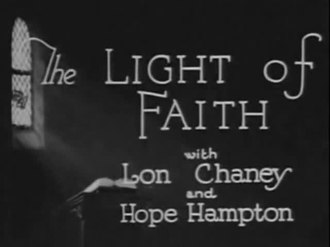The Light in the Dark
| The Light in the Dark | |
|---|---|
 Title Frame | |
| Directed by | Clarence Brown |
| Written by |
|
| Produced by | Hope Hampton (producer) |
| Starring | Lon Chaney |
| Cinematography |
|
Production company | Hope Hampton Productions |
| Distributed by | Associated First National Pictures |
Release date |
|
Running time | 63 minutes (7 reels, 7,600 ft.) |
| Country | United States |
| Language | Silent (English intertitles) |
The Light in the Dark (also known as The Light of Faith and Light of Faith) is a 1922 American silent drama film directed by Clarence Brown and stars Lon Chaney.[1][2]
Plot[]
Coat-check girl Bessie MacGregor (Hope Hampton), is struck by the car of wealthy society woman Mrs. Templeton Orrin (Teresa Maxwell-Conover), who takes Bessie into her home while she recovers. Mrs. Orrin's brother, J. Warburton Ashe (E.K. Lincoln), says he loves Bessie, but when she learns he does not mean it, she flees the home, heartbroken.
Unable to find work, Bessie collapses one day in the boarding house in which she is staying. The landlady, Mrs. Flaherty (Dorothy Walters) and another boarder, Tony Pantelli (Lon Chaney) start to nurse Bessie back to health.
Ashe, realizing he was wrong in his treatment of Bessie, goes on a trip to England to forget about her. During a hunting expedition he finds a mysterious chalice that some believe to be the Holy Grail. Mrs. Orrin urges her brother to return home to help locate Bessie.
Seeing Bessie needs medical care, Tony tries to raise money by stealing the chalice. The police later recover the chalice in a raid on a pawnbroker's shop. News of the cup's mysterious healing powers, and the way it glows in the dark, reaches the newspapers.
After Bessie tells Tony the story of the Holy Grail, he again steals the chalice, this time to cure Bessie who makes a recovery, but Tony is caught and put on trial for the theft. During the trial, Bessie and Ashe are reunited and when Ashe refuses to press the charges against Tony, he is acquitted. Later, the pawnbroker, now in Sing Sing prison, confesses that the mysterious glow was from some radium he had placed in the chalice.
Cast[]
- Hope Hampton as Bessie MacGregor
- E.K. Lincoln as J. Warburton Ashe
- Lon Chaney as Tony Pantelli
- Teresa Maxwell-Conover as Mrs. Templeton Orrin
- Dorothy Walters as Mrs. Flaherty
- Charles Mussett as Detective Braenders
- Edgar Norton as Peters
- Dore Davidson as Jerusalem Mike
- Mr. McClune as Socrates S. Stickles

Production[]
The Light in the Dark was filmed in New York and at the Paragon studio in Fort Lee, New Jersey.[3][4]
Reception[]
A review of The Light in the Dark in Moving Picture World noted: "In introducing the new process of color photography, Associated First National has made doubly secure an offering that from the standpoint of material and treatment promises to give wide satisfaction ... Lon Chaney has the type of role in which he has proven exceptionally skillful. His is a real sympathetic contribution."[5]
The Variety review said, "If its story possessed half the merit of its technical equipment, it might have proved a world-beater. It doesn't, so it isn't ... Mr. Chaney is a somewhat more kindly crook than is his wont, and Mr. Lincoln struggles along in the fat, but unconvincing hero role."[5]
The original seven-reel film was re-edited into a condensed 33-minute version known as The Light of Faith, that was circulated to schools and churches in the 1920s.[6] A copy of the film is in the George Eastman House Motion Picture Collection.[7]
References[]
Notes[]
- ^ Blake 1998, p. 119.
- ^ Anderson 1971, p. 181.
- ^ Blake 1997, p. 111.
- ^ "Stardust and The Light in the Dark". Exhibitors Herald. New York City: Exhibitors Herald Company. 13 (26): 84. December 24, 1921.
- ^ a b Mirsalis, Jon C. "Review: 'The Light in the Dark'." lonchaney.org, 2008. Retrieved: May 9, 2016.
- ^ Blake 1997, p. 72.
- ^ "Progressive Silent Film List: 'The Light in the Dark'." silentera.com. Retrieved: May 9, 2016.
Bibliography[]
- Anderson, Robert Gordon. Faces, Forms, Films: The Artistry of Lon Chaney. South Brunswick, New Jersey: A. S. Barnes, 1971. ISBN 978-0-4980-7726-5.
- Blake,Michael F. The Films of Lon Chaney. Vestal, New York: Vestal Press, 1998. ISBN 978-1-5683-3237-6.
- Blake,Michael F. A Thousand Faces: Lon Chaney's Unique Artistry in Motion Pictures. Vestal, New York: Vestal Press, 1997. ISBN 978-1-8795-1121-7.
External links[]
| Wikimedia Commons has media related to The Light in the Dark. |
- The Light in the Dark at IMDb
- The Light in the Dark at the TCM Movie Database
- The Light in the Dark is available for free download at the Internet Archive
- 1922 films
- American silent short films
- American black-and-white films
- American crime drama films
- American films
- 1922 romantic drama films
- First National Pictures films
- American romantic drama films
- 1922 crime drama films
